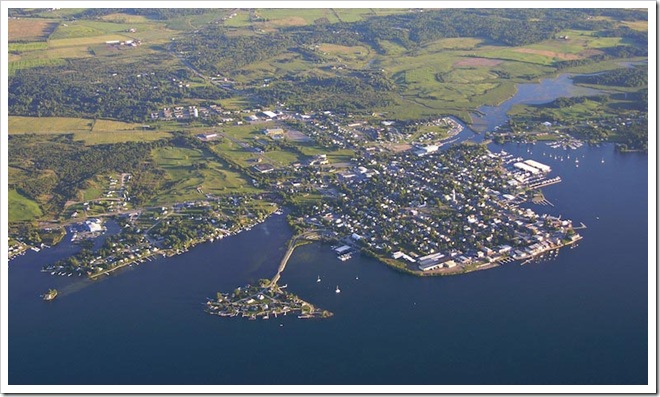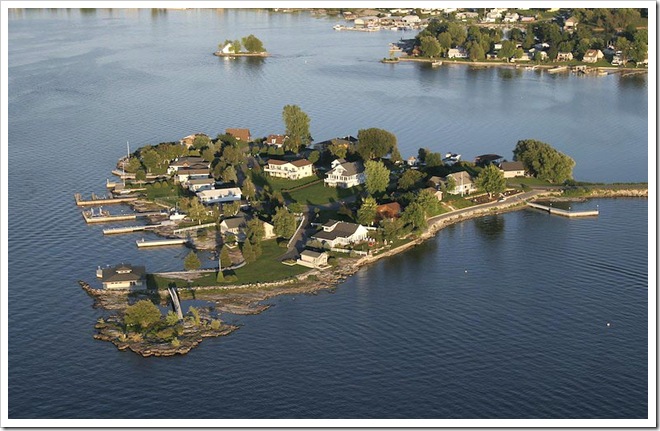Written by
Susan W. Smith posted on November 14, 2008 16:44
Imagine asking the US residents on Washington Island, in Clayton, NY, to change the island’s name back to its original: Barnard. Yes, the island was given the original name in 1816 by Captain William FitzWilliam Owen and it was named after Sir Andrew Francis Barnard. Barnard, born in Ireland in 1773, entered the British Army at nineteen years of age. His biographer claims he was a good soldier, and as will be apparent below, well respected.

Photo by Ian Coristine © www.1000IslandsPhotoArt.com
Washington Island, connected to Clayton by a causeway.
Throughout the winter, I will provide a number of links to demonstrate how our region of the mighty St. Lawrence River should be known as "The Thousand Islands, more than a salad dressing"! Not because the information is unusual, but because there are hundreds of reasons to link our Thousand Islands to important people, places and events. I refer to these links as six degrees of separation – and over the next few months, we will compile a long list to prove that the Thousand Islands is (almost) the centre of the world – and certainly more than a salad dressing!
So let’s begin with Sir Andrew Francis Barnard. He began his military career first as a lieutenant and then a captain when he served in Santo Domingo with Sir Ralph Abercromby in an expedition to the West Indies. In 1808 he was appointed lieutenant colonel and even went to Canada as inspector of the field officers of the militia.
He returned to England in 1809 where he was sent to the Peninsula Wars in 1813 under the direction of Arthur Wellesley, 1st Duke of Wellington. He fought in many of the famous battles including Battle of Ciudad Rodrigo. Badajoz, Salamanca and Vittoria. Barnard received several honours in 1815 for his service in the Peninsular.
When War broke out the second time with Napoleon in 1815, Barnard commanded six companies. He fought at the Battle of Quatre Bras and was slightly wounded at the Battle of Waterloo. Wellington was so impressed with Sir Andrew, he appointed him commander of the British Division during the occupation of Paris.
For the next 35 years Barnard held a series of important posts including being" Groom of the Bedchamber". (Wikipedia tells us that this position focused on intimate aspects of the lives of the royal family.) The King appointed him “equerry”, which is a position of honour, and in 1830 he became a commissioner for “affixing the King’s signature to instruments requiring the same”. He was clerk-marshal to the Royal Household of William IV and his wife Adelaide.
The Duke of Wellington also appointed Barnard Lieutenant-Governor of the Royal Hospital Chelsea, which is still operating today as a hospital for British soldiers who are old and infirmed. Barnard received several honors in his lifetime but the greatest of these was given to him when he died.
He never married and he died at the Royal Hospital Chelsea, in 1855. Shortly before the funeral, several of his fellow soldiers, many of whom served under his command back in the Peninsular Wars, asked the family if they could have a few minutes alone with their commander. The family agreed and when the door to the room was opened and the soldiers left the room the family found the casket covered in laurel leaves as a symbol of high esteem and respect. Each soldier had brought a leaf in their pocket into the room. Barnard is buried on the grounds of the Hospital.
Although it is highly unlikely that Washington Island will be known by its historic name; the residents of Clayton might nevertheless, take pride in knowing this story. And if one would like, there are many links to research that will take you from Barnard to Wellington, to the Peninsular Wars, on to the Royal family, a link to the Royal Hospital Chelsea and finally to the flavourful laurel leaf which we know today as the Bay Leaf.

Photo by Ian Coristine © www.1000IslandsPhotoArt.com
Barnard Island, Named by Captain William FitzWilliam Owen in 1816.
Susan W. Smith SusanSmith@ThousandIslandsLife.com
References:
Dictionary of National Biography (1885–1900)
Wikipedia: http://en.wikipedia.org/wiki/Andrew_Francis_Barnard
More than a Salad Dressing… Years ago, I met a young medical student and I was telling her about my favourite vacation region. I got carried away, and soon I was relating facts about the War of 1812, the ships that plied the St. Lawrence River, the battles… “Gee,” she exclaimed, "The Thousand Islands are more than a Salad Dressing”.
[Six degrees of separation refers to the idea that if you are one "step" away from each person you know, then you are two "steps" away from each person who is known by one of the people you know, and you are no more than six "steps" away from each person on earth. http://en.wikipedia.org/wiki/Six_degrees_of_separation.]